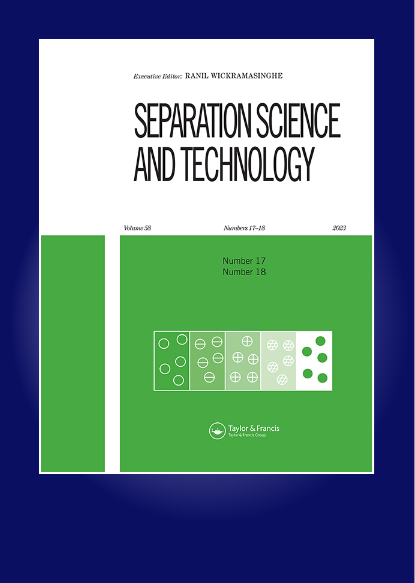Improving anti-fouling properties of alumina tubular microfiltration membranes through the use of hydrophilic silica nanoparticles for oil/water separation
IF 2.3
4区 工程技术
Q3 CHEMISTRY, MULTIDISCIPLINARY
引用次数: 0
Abstract
ABSTRACTIn this study, hydrophilic silica nanoparticles (Si NPs) were used to modify α-alumina tubular membranes to improve their performance in terms of flux, oil rejection, and anti-fouling properties. Our work focuses on enhancing membrane performance, particularly for difficult applications such as produced water treatment. The prepared membranes were applied for oil-in-water emulsion treatment. After coating hydrophilic Si NPs, the oil contact angle improved from 133.8° to 171.4°. To prevent Si NPs from leaching off the surface of α-alumina tubular membranes, polyvinyl alcohol was used to coat the membranes as a pre-treatment step before Si NP modification. After coating the membrane with Si NPs, the roughness of the membrane surface decreased, likely leading to less fouling. After coating Si NPs, Total Organic Carbon rejection increased from 93.1% for pristine α-alumina tubular membranes to 97.7% for silica-modified membranes because of hydrophilic improvements of the modified membranes. The Si NP coating improved the anti-fouling property of membranes with the flux recovery ratio increasing from 71.3% for pristine α-alumina tubular membranes to 85.9% for silica-modified membranes. Scanning Electron Microscopy, Energy-dispersive X-ray spectroscopy, oil contact angle, and Atomic Force Microscopy characterization tests were done. The tests showed successful Si NPs impregnation and altered wettability.KEYWORDS: Oil/Water emulsionmembrane filtrationdip coatinghydrophilicitysilica modification AcknowledgmentsWe want to thank Dr. Imran Shaik for his assistance in measuring the oil contact angles.Disclosure statementNo potential conflict of interest was reported by the author(s).Statement of noveltyThe membrane development technique combines a novel pre-treatment method (using Polyvinyl alcohol) and a silica grafting technique to produce stable fumed silica coatings on membranes. After incorporating the hydrophilic Si NPs, the oil contact angle (OCA) improved from 133.8° to 171.4°. In addition, the surface roughness and associated containment traps on the membrane surface decreased, likely leading to less fouling. Total Organic Carbon (TOC) rejection increased from 93.1% for pristine α-alumina tubular membranes to 97.7% for silica-modified membranes because of hydrophilic improvements of the modified membranes. The Si NP coating improved the anti-fouling properties of membranes as evidenced by the flux recovery ratio increasing from 71.3% for pristine α-alumina tubular membranes to 85.9% for silica-modified membranes. To the best of our knowledge, there are no literature sources reporting the separation of oil and water using α-alumina membranes modified with fumed silica in a continuous cross-flow process.Additional informationFundingThe work was supported by the National Science Foundation under Grant No. OIA-1946093.利用亲水二氧化硅纳米颗粒进行油水分离,提高氧化铝管状微滤膜的抗污性能
摘要:本研究采用亲水二氧化硅纳米颗粒(Si NPs)对α-氧化铝管状膜进行改性,以提高其通量、排油性能和防污性能。我们的工作重点是提高膜的性能,特别是在困难的应用,如采出水处理。将制备的膜用于水包油乳液处理。涂覆亲水Si NPs后,油接触角由133.8°提高到171.4°。为了防止Si NPs从α-氧化铝管状膜表面浸出,采用聚乙烯醇包覆α-氧化铝管状膜作为Si NP改性前的预处理步骤。在膜上涂上Si NPs后,膜表面的粗糙度降低,可能导致污染减少。涂覆硅纳米粒子后,α-氧化铝管状膜的总有机碳截留率从93.1%提高到97.7%,这是因为改性膜的亲水性得到了改善。Si NP涂层提高了膜的抗污染性能,通量回收率从原始α-氧化铝管状膜的71.3%提高到硅改性膜的85.9%。扫描电镜、能量色散x射线能谱、油接触角和原子力显微镜表征测试。试验表明,Si NPs浸渍成功,润湿性发生改变。关键词:油/水乳液膜过滤,浸渍涂层,亲水性,二氧化硅改性感谢Imran Shaik博士在测量油接触角方面的帮助。披露声明作者未报告潜在的利益冲突。该膜开发技术结合了一种新的预处理方法(使用聚乙烯醇)和二氧化硅接枝技术,在膜上产生稳定的气相二氧化硅涂层。加入亲水Si NPs后,油接触角(OCA)由133.8°提高到171.4°。此外,膜表面的表面粗糙度和相关的遏制陷阱降低,可能导致较少的污染。总有机碳(TOC)截留率由原始α-氧化铝管状膜的93.1%提高到硅改性膜的97.7%,这是因为改性膜的亲水性得到了改善。Si NP涂层改善了膜的抗污染性能,通量回收率从原始α-氧化铝管状膜的71.3%提高到硅改性膜的85.9%。据我们所知,目前还没有文献报道在连续横流过程中使用气相二氧化硅改性α-氧化铝膜分离油和水。本研究由美国国家科学基金会(nsf)资助。伊- 1946093。
本文章由计算机程序翻译,如有差异,请以英文原文为准。
求助全文
约1分钟内获得全文
求助全文
来源期刊

Separation Science and Technology
工程技术-工程:化工
CiteScore
6.10
自引率
3.60%
发文量
131
审稿时长
5.7 months
期刊介绍:
This international journal deals with fundamental and applied aspects of separation processes related to a number of fields. A wide range of topics are covered in the journal including adsorption, membranes, extraction, distillation, absorption, centrifugation, crystallization, precipitation, reactive separations, hybrid processes, continuous separations, carbon capture, flocculation and magnetic separations. The journal focuses on state of the art preparative separations and theoretical contributions to the field of separation science. Applications include environmental, energy, water, and biotechnology. The journal does not publish analytical separation papers unless they contain new fundamental contributions to the field of separation science.
 求助内容:
求助内容: 应助结果提醒方式:
应助结果提醒方式:


